
Lake Simcoe Science
A Fish Tale
Fish are Important Measures of Ecosystem Health
It is widely understood that biodiversity is a measure of ecosystem health. An ecosystem rich in biodiversity is more resilient to stressors and changes, provides better ecosystem services such as air and water purification, and provides more resources for recreational, cultural or economic purposes.
In the streams, rivers and creeks of the Lake Simcoe watershed, a key measure of biodiversity is found in fish populations. As a top predator in aquatic systems, fish populations respond not only to direct stressors (such as water quality) but also to stressors that affect the complex food web that supports them. Rivers have often been referred to as a mirror that reflects the health of the surrounding area. Fish, their primary resident, tells us a lot about the neighbourhood.
Did you know…
56 species of fish have been captured in Lake Simcoe tributaries over the last 57 years.
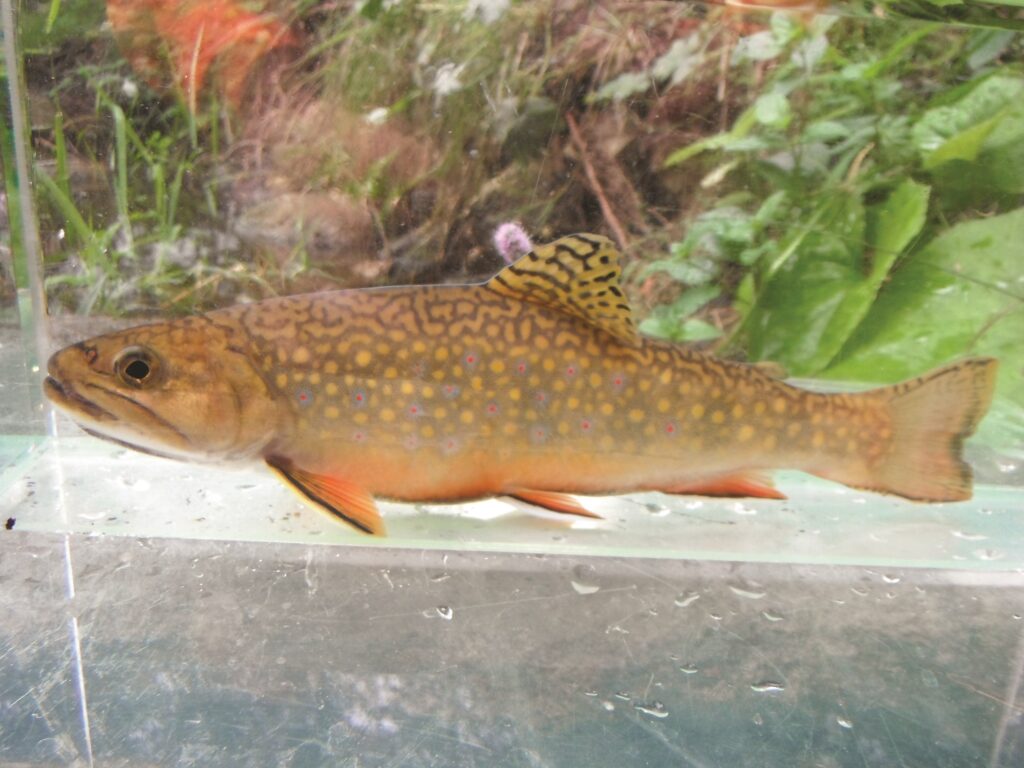
- 39 are native species
- 1 is at risk
- 17 are non-native; 3 are aggressive invaders
Rivers have often been likened to a mirror that reflects the health of the surrounding area. Fish, their primary resident, tells us a lot about the neighbourhood.
Photo of Brook Trout by Larry Halyk
Monitoring fish populations over time
Almost all of the 4,225 kilometres of streams and rivers in the Lake Simcoe watershed are home to diverse fish populations. Since 2002, the Lake Simcoe Region Conservation Authority (LSRCA) has been monitoring these populations and their habitat each year.
The presence or absence of fish populations and the numbers found tells us a great deal about the health of the river. When we capture sensitive species such as brook trout and mottled sculpin, it generally indicates that the stream is cold, clean and healthy.
At sites where we capture species more tolerant of degraded conditions such as creek chub or an invasive species like the round goby, we know that the waters have been negatively impacted.
Annual monitoring tells us if the health of the river is getting better or worse.
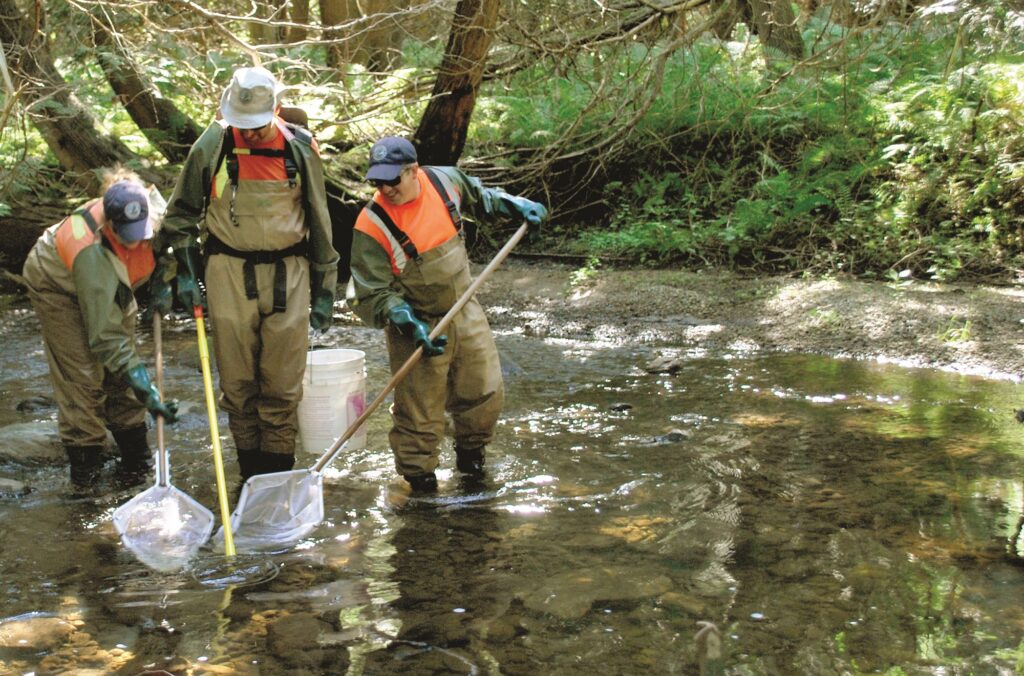
According to Our Research … The Story is Good
The biodiversity of fish species at a site tells us how healthy that section of stream is. Using a scientific tool known as an Index of Biological Integrity (IBI) we assign a health score and compare various stream systems within the watershed as well as track changes at sites over time.
The good news is that the majority of sites (79%) we monitor in the Lake Simcoe basin are in “fair” or “good” condition with only 21% of the sites scoring a “poor” or “very poor” grade.
Fish Community Health in Lake Simcoe Rivers
The pie charts illustrate the proportion of IBI ratings (health scores) for each subwatershed within the Lake Simcoe tributaries.
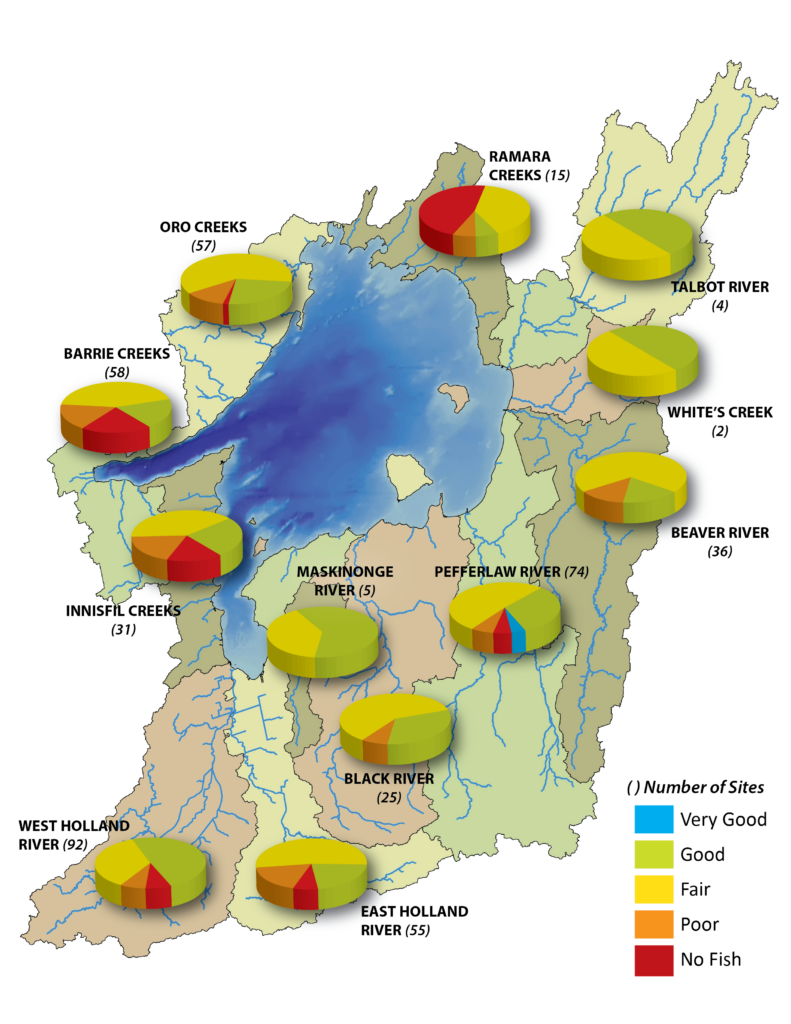
Natural Land Cover Keeps Streams Cool
The subwatersheds with “good” scores typically have headwaters originating on the Oak Ridges Moraine (ORM), such as the East and West Holland and Pefferlaw River systems. These areas typically have more natural land cover and vegetation along the rivers’ edge that serve to keep the streams cool. The buffer of native grasses and trees filters nutrients such as phosphorus which soak into the ground rather than run-off directly into the water. Because they are on the Oak Ridges Moraine, these sites are also influenced by springs and groundwater sources that contribute cold, clean water to the system.
Sites that score poorly typically coincide with urban areas where streams have been altered and experience more extreme flows and stormwater run-off.
We have been monitoring 29 sites across the watershed since 2002. While still a relatively short period of time from a scientific perspective, trends in the IBI scores show that the majority of the sites (55%) display stable scores of “fair” while 22% of the sites consistently yield a score of “good”. The stability of these scores over the last 10 years tells us that the fish communities have remained relatively unchanged. Of the remaining sites, 13% showed a trend of getting better and 10% showed a trend of getting worse.
While the IBI is a measure of overall diversity, there are a few key species that have a greater impact on the score. A number of the sites showing an improving trend are related to the capture of brook trout where they were not captured before. Conversely, declining trends are linked to sites where brook trout are no longer captured or where invasive species such as the round goby have begun to be captured.
From an ecosystem health perspective
Fish communities in our watershed have remained relatively stable over the past 10 years, with only 10% of the sites we monitor showing a declining trend.
Brook Trout: The Fresh Water Equivalent of the Canary in the Coal Mine
Generally only the healthiest tributaries in the Lake Simcoe watershed can support brook trout, as they have specific requirements including the need for cold, clear water and gravel bottoms. Brook trout prefer water temperatures between 13OC and 18OC and are highly sensitive to even small changes in temperature, oxygen levels, pH levels, or decreases in water quality.
Because of their environmental sensitivity, we typically find the majority of brook trout in the cold, fast flowing headwater streams on or near the Oak Ridges and Oro Moraines. It is rare to find brook trout in highly urbanized areas. A notable exception to this is the City of Barrie, where populations are still being found. We believe that their continued survival in Barrie is due to the strong groundwater upwellings in the streams that serve to keep the water cold. We are working with the City of Barrie to maintain and, where possible, enhance the habitat for this keystone species.
Brook Trout and Mottled Sculpin Capture Sites
Brook Trout are found predominantly in the headwaters on or near the Oak Ridges and Oro Moraines. Mottled Sculpin, having slightly less stringent habitat requirements, show a greater distribution throughout the watershed and serve as an indication where restoration ef forts could pave the way for brook trout reestablishment.
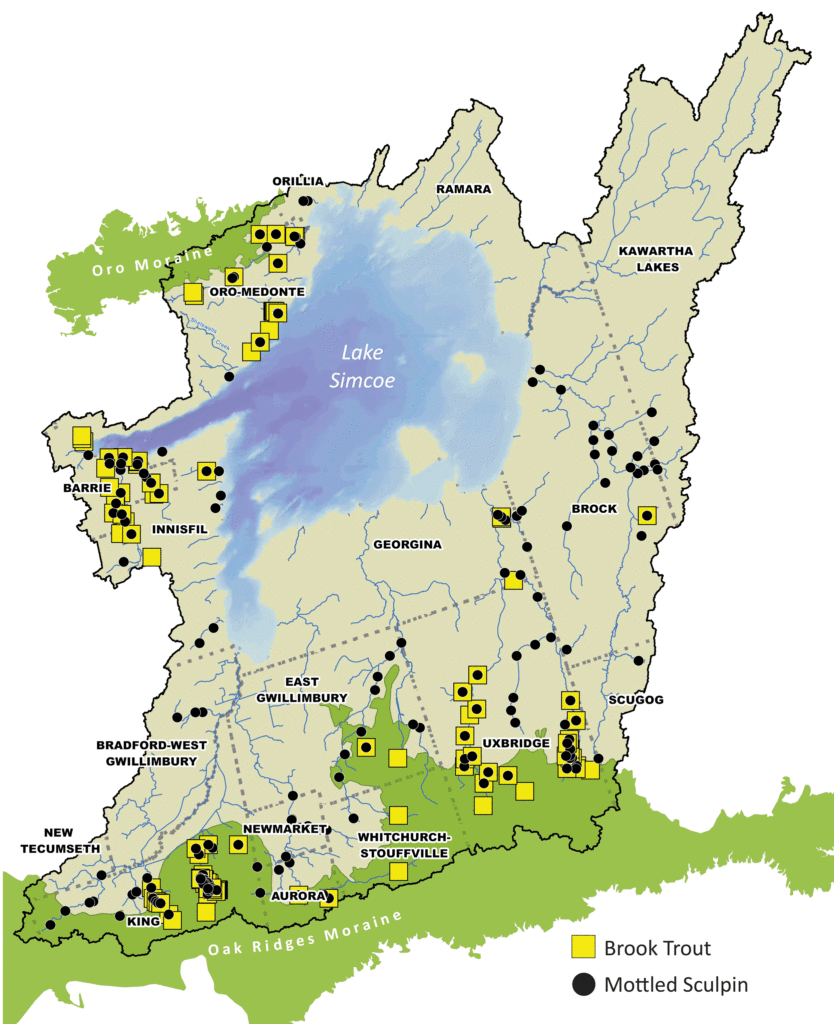
Bringing Brook Trout Back
Mottled sculpin also live in the cool and cold water streams of the Lake Simcoe watershed, although they are more tolerant of warmer temperatures than brook trout. Streams supporting only mottled sculpin are therefore considered good areas to focus restoration efforts since they have the best chance of once again supporting a brook trout population. One such area identified is in the smaller tributaries of the Beaver River (in the central east section of the watershed).
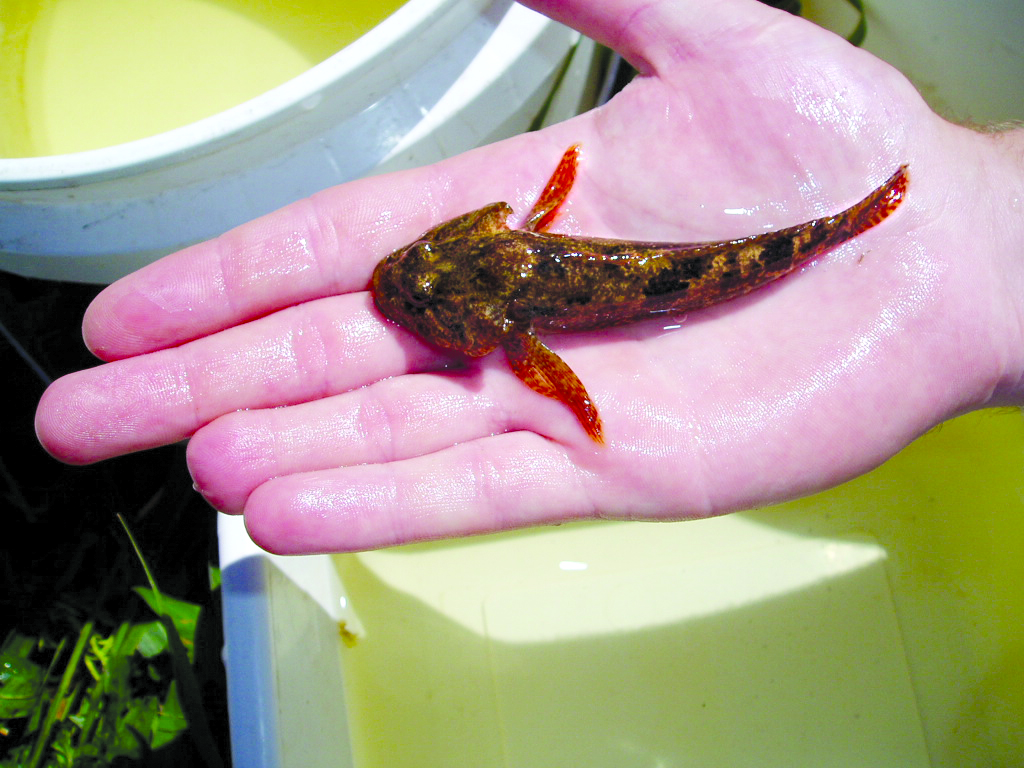
The presence of mottled sculpin is one indicator that restoration efforts could bring back brook trout to areas they may have abandoned.
The return of brook trout to an area where we’ve undertaken restoration, is just one indication that our efforts have been successful.
Trouble Spot: The Invasive Round Goby
The round goby is an invasive species of great concern. Populations were first discovered in our watershed in the Pefferlaw River in 2004, likely brought in through the release of live bait. In 2005 unsuccessful efforts were made to eradicate them. They have since spread throughout Lake Simcoe.
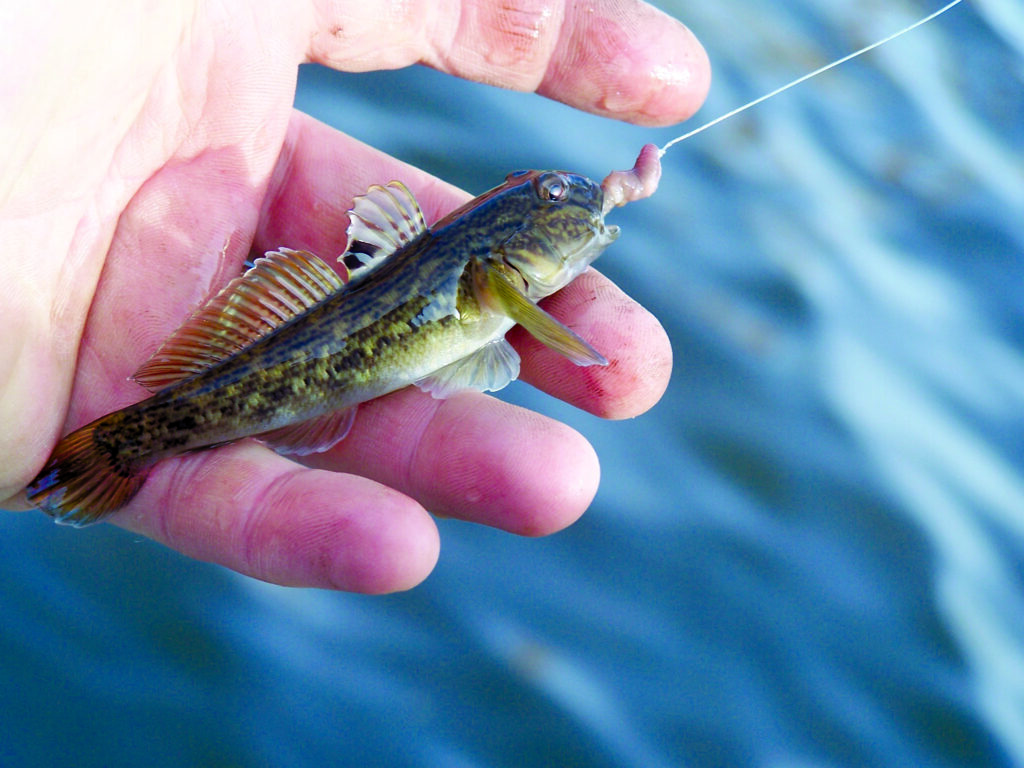
Round gobies are an aggressive species that reproduce quickly and feed on the eggs of native species, therefore outcompeting them.
Invasive species populations impact watershed health (IBI) scores. The presence of the goby in the Pefferlaw River has caused the IBI score to go from “good” to “fair” in just six years. With their spread through the lake, gobies have recently been caught in the mouths of many other river systems and we are likely to see additional IBI declines as a result.
Round goby expansion into the mid reaches and headwaters of Lake Simcoe tributaries will largely be prevented by existing barriers, such as dams, that will block their progress. However, anglers still have a role to play in preventing their further spread by following best practices such as not releasing live bait.
The failure to eradicate the round goby in our watershed illustrates the importance of prevention. Most invasive species are introduced as a result of human activities. Once an invader arrives, it is extremely difficult to eliminate.
Preventing the Spread of Invasive Species is Easy
- Dispose of live bait in the trash, not in the water.
- Take unwanted aquarium fish or plants back to your local aquarium store.
- Clean your boat after bringing it out of the lake, especially if moving to another body of water.
How LSRCA is working to improve the quality of Lake Simcoe
We are working to improve fish habitat in our watershed through the implementation of improvement projects, which range from riparian plantings to stream realignments and barrier removals. These efforts improve water quality, create or enhance habitat, and allow fish passage into areas where they have been previously restricted thereby improving diversity throughout the system.
LSRCA works with its many partners, including our communities and municipal, provincial, and federal governments, to protect and restore the environmental health and quality of Lake Simcoe and its watershed. We do this by leading and supporting programs and projects in science and research, protection and restoration, and education and engagement.
- Lake and tributary monitoring
- Subwatershed planning
- Development and testing of new tools and innovative technologies for phosphorus reduction
- Working with landowners to implement restoration projects
- Public and youth education
Who to Contact:
Customer Service
Phone: 905-895-1281
Toll Free: 1-800-465-0437
Email: info@LSRCA.on.ca
This newsletter was published in Lake Simcoe Living Magazine in 2013.
